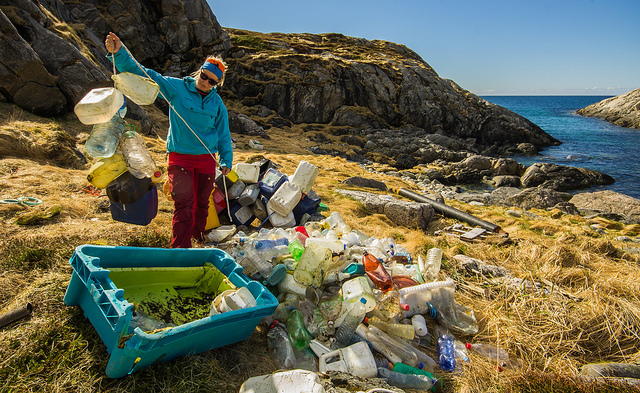California Adopts Nation-Leading Legislation to Cut Plastic Pollution
Extended producer responsibility law will reduce single-use waste and shift responsibility to industry

In a welcome reprieve from news coming out of the Supreme Court, here’s an uplifting story from the Golden State: On Thursday, Governor Newsom signed SB 54, a comprehensive piece of legislation aimed at significantly reducing single-use waste. The law will affect just about every type of plastic packaging you see walking down the supermarket aisle in California, and it’s a major step in the fight to reduce plastic waste, over 90 percent of which does not get, and much of which cannot currently be, recycled. It’s an extended producer responsibility law, which means that it is designed to require producers to take responsibility for what happens to their products at the end of those products’ usable lives.
This law is a long time in coming—the first iteration introduced by State Senator Ben Allen debuted back in 2019—and represents arduous efforts to achieve bipartisan support for a strong regulatory framework that shifts responsibility back onto the producers that generate the single-use trash clogging our waterways and damaging our marine ecosystems. (Our California Environmental Legislation & Policy Clinic was fortunate enough to contribute to those efforts: Special shoutout to Sean Anderson, Kelsey Manes, Reilly Nelson, and Justin Breck for their tremendous work!)
A bit more on the history in a minute, but first, a high-level overview of what the law does. Among other things, it will require:
- All single-use packaging and food service ware to be recyclable or compostable by 2032;
- A 25 percent source reduction of single-use plastic waste against 2023 levels, meaning that by 2032, industry has to have stopped distributing an amount, by unit count and weight, of plastic equal to 25 percent of the plastic packaging that was distributed in California in 2023;
- Achievement of progressively stronger recyclability targets, with an ultimate requirement that 65 percent of single-use plastic packaging and food service ware be recyclable by 2032;
- Significant state oversight by CalRecycle, the state agency that regulates waste management, as producers comply with the law’s requirements—all producers covered by the law have to join a state-approved producer responsibility organization (PRO) or comply with the law’s terms without joining it. Among other things, the PRO will be responsible for annual reporting to CalRecycle and for coming up with and implementing a plan to achieve the law’s targets (non-member producers would have to do these things themselves), and the law imposes $50,000/violation/day penalties; and
- Payment of an annual mitigation fee of $500 million ($5 billion in funds by 2032), which will be used to combat the harmful effects of single-use trash pollution on the environment and human health, with a particular focus on addressing impacts in the environmental justice, disadvantaged, low-income, and rural communities that disproportionately suffer these burdens.
In adopting this law, California joins a handful of other states with extended producer responsibility laws on the books, which brings me back to the history: A substantially different version of this bill failed in an end-of-session vote in 2019. Environmental groups then joined with Recology, a waste management company based in San Francisco, to certify a ballot initiative for inclusion on the November 2022 ballot. That initiative would have authorized CalRecycle to adopt and enforce regulations requiring that 80 percent of single-use plastic packaging and food service ware, as compared to 2020 levels, be recyclable, compostable, or source reduced by 2030, with an additional requirement that 25 percent of the waste be source reduced. It also would have charged producers and distributors of single-use packaging and food service ware a fee of up to 1 cent on each item intended for final sale in California and used that money to address the impacts of single-use plastic waste, especially in disadvantaged, low-income, and rural communities. Then, in 2021, Oregon and Maine passed their own extended producer responsibility laws (Colorado followed earlier this year)—each with its own unique structure.
With a strong ballot initiative poised to go to the voters this November and a couple of success stories on the books, the playing field had changed. Industry made it clear that it would fight the initiative, which polled well with voters, tooth and nail, but the pressure was on for them to come to the negotiating table. And environmental groups held fast through the negotiations, refusing to compromise on a law that wouldn’t meet their core objectives. The bill took key amendments in the Assembly Natural Resources Committee, chaired by Assemblymember Luz Rivas, including important details about the mitigation fee and its disbursement. The negotiations went down to the wire—yesterday was the final day for the initiative to be withdrawn from the November ballot—but were ultimately successful.
The end result is a nation-leading law that meaningfully shifts the responsibility for managing the burdens of single-use waste off the shoulders of taxpayers and back on to industry. Coupled with last year’s truth in labeling law, SB 343 (also introduced by Senator Allen), which ensures that products advertised as “recyclable” or “compostable” truly meet that characterization, California is tackling single-use plastic waste head on.







Reader Comments